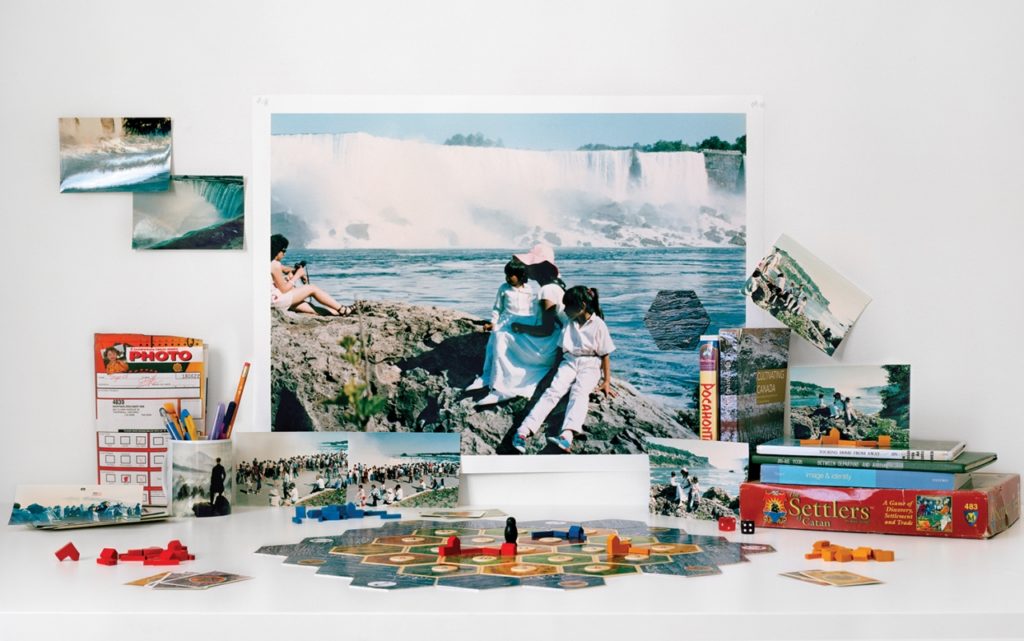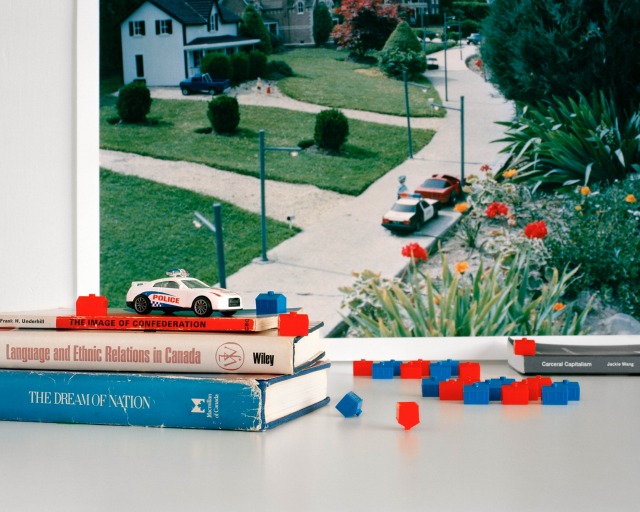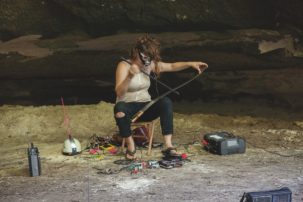The Scotiabank CONTACT Photography Festival launches across Toronto this week with exhibitions at almost 200 venues. Here are seven projects that are must-sees for Canadian Art’s team. (And also watch next week for our interview with one of the key artists at this year’s festival, Carrie Mae Weems.)
Zinnia Naqvi, “Yours to Discover”
Peel Art Gallery Museum and Archives, May 2 to October 20
As a preteen I had to negotiate a tortured love affair with the likes of Hole, Leonardo DiCaprio and Stephen King in a household where Sade, Angela Davis and Toni Morrison were more likely to take centre stage. I was reminded of this cultural discord in 2017 when I saw Zinnia Naqvi’s vitrine installation Heart-shaped Box. In an old home video, Naqvi, who was three at the time, energetically sings along to grunge music with her two sisters. Naqvi painted the entire vitrine pink and surrounded the video with the CDs, posters and books of coming-of-age ’90s girlhood. The girls, whose family had moved to Canada from Pakistan only a few years earlier, are completely immersed in the angst of a North American subculture.
This year for CONTACT, Naqvi presents Yours to Discover, a site-specific installation outside the Peel Art Gallery Museum and Archives that echoes the earlier vitrine work. This time the artist photographs arrangements of personal ephemera from her family’s early excursions to popular tourist sites in Canada. Also, as one of this year’s winners of the Scotiabank New Generation Photography Award, Naqvi and the other winners, Luther Konadu and Ethan Murphy, will participate in a group exhibition at the Gladstone Hotel, which will also be remounted at the National Gallery of Canada in the fall. —Yaniya Lee, associate editor
Sanaz Mazinani, “Not Elsewhere”
Aga Khan Museum, May 1 to May 31
Mazinani’s work often abstracts familiar forms—including the recognizable shapes of drones and combat aircraft used here—into elegant, mathematically repeating compositions. For this public installation, three 91-foot-long fabric scrolls hang in the Aga Khan’s light-filled courtyard, dramatically scaling up the intimacy of a scroll to the height of building. While the title suggests that the machinery of war is indeed “not elsewhere,” the use of computer-generated imagery on these kaleidoscopic scrolls reminds us of where war is the most insidious: hidden in the plain sight of instantaneous news cycles endlessly repeating on our digital devices. — Jayne Wilkinson, managing editor
ALEX MCLEOD, “GHOST STORIES”
Division Gallery, April 11 to June 8
Alex McLeod’s goopy multicoloured forms take on feeling and an uncanny relationship to reality, unlike the skepticism I sometimes feel about highly detailed digital renderings and their tendency to fetishize technology. In “Ghost Stories,” vibrant or sickly bright colours seem to melt like sugar tar over molecular visions, landscapes, abstract living entities and object forms. It’s as if these images, partly built with “rejected pixels,” reveal a shadow side of the real world, a tangible depiction of the organic and technological ghosts we can’t see that are stabs of electricity in the air. Other elements—animations and 3D-printed sculptures finished with paint and textiles by the artist—reflect the material and metaphorical spillage between imaged and invisible worlds. As a one-night event on May 8, McLeod and opera singer Meghan Lindsay will also present an immersive experience in the gallery, an exciting sensory wake-up for the visually tired. —Joy Xiang, editorial resident
Carmen Winant, “XYZ-SOB-ABC”
Billboards in Toronto, Calgary, Edmonton, Halifax, Montreal, Ottawa, Saskatoon, Vancouver and Winnipeg, May 2019
It doesn’t take a lot to make me happy. Put the words “Free Daycare” on a billboard and I’m pretty pleased. Even more so if those words are pulled from archival photographs of women’s protest actions. And even more so if the billboards are across the country. All these elements, fortuitously (at least, fortuitously for me) come together in Carmen Winant’s XYZ-SOB-ABC. A need for gratis childcare is not the only protest message Winant focuses on. There are others, too, all closely cropped. “As a strategy,” Winant writes, “the crop is both generous and unfair—it underscores a message while removing its historical specificity.” This gesture to context excluded also pertains, in my view, to many images of women in public space. And where better to put these text-image crops but back on billboards, which, as Winant puts it, are “the grand conveyor of gendered behaviour”? There are many loops here to open and close—rage and repression, action and inaction, present and past—and if you’re of my ilk, even those loops, made visible, can be quite pleasing also. —Leah Sandals, news and special sections editor
Beatrice Gibson, “Plural Dreams of Social Life”
Mercer Union, April 13 to June 1
Mercer Union presents two video installations for this exhibition: Deux Soeurs Qui Ne Sont Pas Soeurs (2019) and I Hope I’m Loud When I’m Dead (2018). The latter stands out: it’s a deeply ambivalent film about how to live and die in a scary time that also, somehow, has joy. But it’s cathartic, too, and Gibson’s anxieties get channelled through various symbolic mechanisms: images of war, poetry readings from CAConrad and Eileen Myles, a poodle cameo and special final scene that I won’t give away. Together, the films (presented by Mercer Union as “sororal companions”) are not as much about what we make for the world as they are about whom we make—literally with our bodies, and textually by way of citation—and how those more-than-material legacies call for a kind of ethics of living. —Erin Saunders, copy chief
Arnait Ikajurtigiit, “Women Helping Each Other”
Art Gallery of York University, April 17 to June 23
International art communities have taken an interest in circumpolar arts as of late. But the Arnait collective has remained, for decades, unflinchingly devoted to mentorship between Inuit women. Arnait Ikajurtigiit, Arnait’s original name in Inuktitut, translates into English as “women helping each other.” Drawing from the values of its collective members, Arnait’s work centres on kinship between women and community-based methods that grow from Inuit women’s collective capacity. Founded by a group of Inuit and non-Inuit women in Igloolik in 1991, Arnait has been home to hard-hitting northern cultural workers such as Mary Kunuk, Atuat Akittirq, Carol Kunnuk, Alethea Arnaquq-Baril and Lucy Tulugarjuk. The works in “Arnait Ikajurtigiit: Women Helping Each Other” include film, objects and photography, and reflect on the cyclical relationship of mentorship inherent in the movement of all Inuit life. —Lindsay Nixon, editor-at-large
“Developing Historical Negatives,” group exhibition
Gallery 44, May 3 to June 1
Archives exist in multiple states: as traces of the past seen through the often-fractured lens of history; as reflections on the present held in the hands of younger generations; and as projections of possible futures that build on the memories and hopes that these records both embody and elicit. This group exhibition, curated by Gabrielle Moser and including commissioned works across media by Deanna Bowen, Morris Lum, Jacqueline Hoàng Nguyễn, Krista Belle Stewart and Hajra Waheed, unpacks photographic archives—both personal and institutional—as raw material for an expanded subversion of transnational colonial perspectives. Taken together, these works offer new perspectives that not only diverge from and challenge “official” narratives, but also refocus and reveal the untold and overlooked aspects of our shared history as a kind of pre-existing blueprint for a collective path forward. —Bryne McLaughlin, senior editor

 Zinnia Naqvi, The Wanderers - Niagara Falls, 1988, 2019. Courtesy the artist.
Zinnia Naqvi, The Wanderers - Niagara Falls, 1988, 2019. Courtesy the artist.







